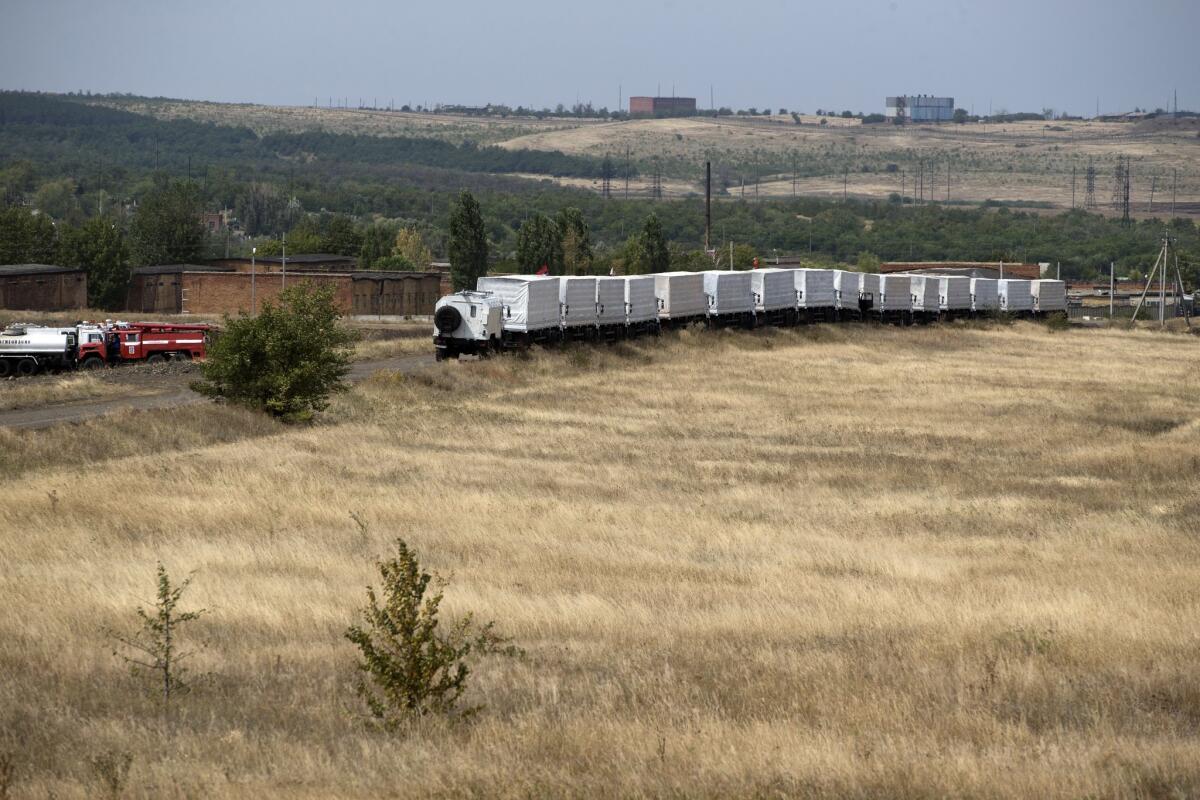Ukraine says separatists’ rockets incinerated civilian convoy

- Share via
Reporting from Kiev, Ukraine — A line of cars and minibuses carrying civilians out of embattled eastern Ukraine was hit Monday by what Kiev authorities said was separatist rocket fire that killed dozens.
The Grad rocket strike set the convoy on fire as it traveled east from towns near the city of Luhansk that were recently recovered by Ukrainian government forces. The vehicles were incinerated by the blast and their occupants had no chance to escape, a Ukrainian security official told journalists in Kiev, the capital.
“The rebels were expecting the convoy and destroyed it entirely,” said Col. Andriy Lysenko, spokesman for the National Security and Defense Council.
He said the exact death toll was unknown but that dozens were killed — a scene of carnage he described as “very graphic.”
Another military spokesman, Anatoly Proshin, told Ukraine’s Channel 112, “The force of the blow on the convoy was so strong that people were burned alive in the vehicles; they weren’t able to get themselves out.”
The ambush, which a separatist news website denied was the work of the pro-Russia insurgents, occurred at 9:40 a.m. as the caravan attempted to make its way to safer territory under Ukrainian military escort, officials said.
United Nations humanitarian agencies report that at least 344,000 people have fled eastern Ukraine because of the fighting, which has intensified in recent weeks. About half have gone to Russia’s Rostov region and the rest to western Ukraine.
The attack followed a weekend of further government incursions into eastern territory seized by the insurgents in March and April, after Russian President Vladimir Putin sent troops to Ukraine’s Crimea region and engineered its secession and March 18 annexation to Russia.
Putin has been sending mixed signals about his intentions in eastern Ukraine’s Luhansk and Donetsk regions, which the separatists held for four months before a reinvigorated government counteroffensive began rolling them back. The militants have lost more than half of the territory they once held and are reportedly encircled in the two urban centers that are their last redoubts.
The rebellion has been weakened by the retreat to Russia of at least three separatist leaders over the last week, leaving the insurgency in the hands of less experienced local militants opposed to rule from Kiev.
But in a sign of the insurgents’ surviving firepower, a Ukrainian fighter jet was shot down Sunday as it provided air support to the campaign to oust the separatists from Luhansk, Ukrainian and Russian news media reported.
Despite the defections from the rebellion’s military and political leaderships, the separatists continue to fight a fierce rear-guard action as government troops close in. Casualties on both sides have been mounting over the last month, since the apparently accidental downing of a Malaysia Airlines passenger jet July 17 killed all 298 people on board and drew international outrage. The missile that brought down the jet was fired from separatist-held territory, according to Western intelligence sources.
Britain’s Guardian newspaper reported over the weekend that its sources in the area had witnessed the arrival of dozens of Russian tanks and armored vehicles and hundreds of gunmen in what appeared to be an effort by Moscow to shore up the insurgency.
Meanwhile, a convoy carrying humanitarian aid for trapped civilians in Luhansk remained on the Russian side of the border a week after it was dispatched from Moscow.
After talks in Berlin on Sunday with his counterparts from Ukraine, Germany and France, Russian Foreign Minister Sergei Lavrov said the humanitarian nature of the aid had been established to all parties’ satisfaction after a joint inspection of the first group of trucks from the 280-vehicle convoy.
But officials of the International Committee of the Red Cross, whose workers are escorting the aid and plan to deliver it, said they were still waiting for guarantees from the Ukrainian government and the insurgents that foreign relief workers could operate safely in the area.
Many of the remaining 200,000 residents of Luhansk, once a city of 465,000, have been without electricity, running water or communications for two weeks, separatist leaders have said on their news websites.
Irina Verigina, the Kiev-allied governor of Luhansk who has been sidelined for months by separatist leaders, was quoted by CNN as saying the region didn’t want aid from Russia.
“They send us tanks and Grads overnight and offer to send humanitarian aid by day,” Verigina said.
Special correspondent Butenko reported from Kiev and Times staff writer Williams from Los Angeles.
Follow @cjwilliamslat for the latest international news 24/7
More to Read
Sign up for Essential California
The most important California stories and recommendations in your inbox every morning.
You may occasionally receive promotional content from the Los Angeles Times.














